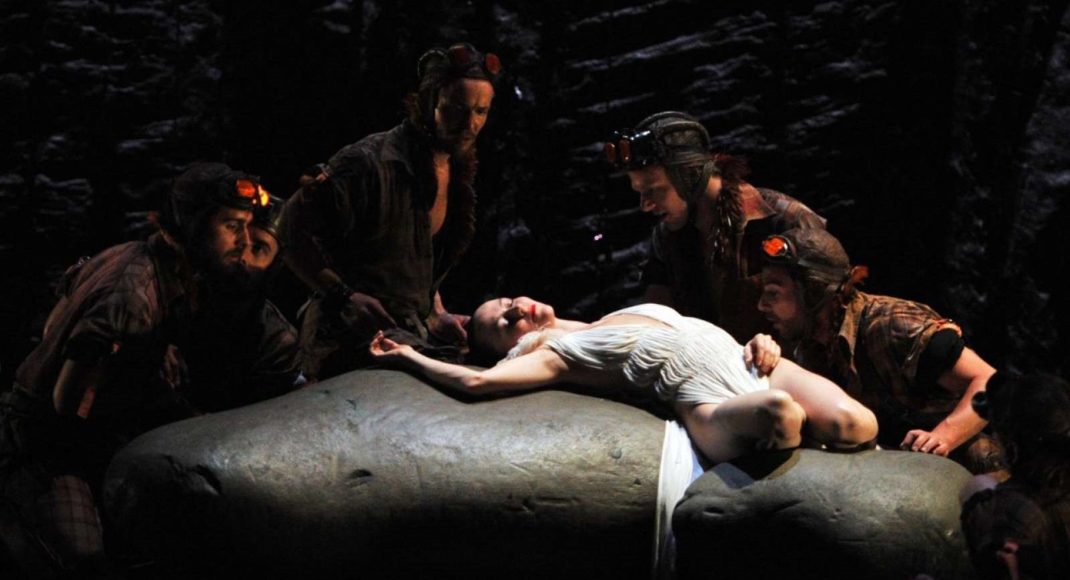9 June 2018, Joan Sutherland Theatre, Sydney Opera House
A death scene begins and ends Ballet Prelocaj’s Snow White. As the ballet opens, we see Snow White being born and gathered up by her father as her mother writhes on the floor and dies. As the ballet ends the stepmother (the Queen) is forced to dance in burning shoes until she dies. Both moments are compelling and there is nothing sweet and charming (or Disney-like) in this version of the story. Choreographer Angelin Preljocaj has gone back to the original story by the Brothers Grimm, and grim it indeed it is. Having said that there is one truly delightful moment at the beginning when, while holding his new-born child in his arms, the father (the King) passes behind an upstage screen and emerges on the other side with a beautiful little child holding his hand. This theatrical moment showed the passing of time but was enhanced by the absolute delight of the little girl at being on stage.
Choreographically Snow White had one truly astonishing sequence. After having the poisoned apple shoved (and I mean shoved with absolutely vile intent) down her throat by the Queen, Snow White’s apparently lifeless body is discovered by the Prince. He and she have met before and have already established a relationship so he is bereft to find her in this state. A pas de deux begins and what makes it remarkable is that there is exciting partner work here as the Prince lifts and flings Snow White’s apparently lifeless body around him until the apple is dislodged. They then continue the pas de deux with delicious softness and romanticism.

I also enjoyed the moments when we met the seven miners who discover Snow White asleep in the forest that is their workplace. They were not little people in this Snow White but their occupation was clear as we watched them moving up and down a sheer rock face (sets by Thierry Leproust) using ropes to aid the process. Discovering Snow White lying exhausted on the forest floor they were curious about her. The dance they performed together (in between getting on with their climbing activities) demonstrated their close-knit ties to each other and their curiosity about Snow White. I have to admit I was reminded of Meryl Tankard’s works at this point, partly as a result of the use of ropes as part of the choreography. But there were moments of choreography that looked quite linear or geometric and my mind went back to the Hungarian dancers in Tankard’s Wild Swans.
Other parts of the choreography were not quite so engrossing. The early scene, when Snow White and her father sat on their elevated thrones and watched their subjects dancing, contained some interesting moves that seemed to me to look back to court dancing. But this sequence was far too long and in the end seemed like a fill-in rather than part of the story. Despite this, for the most part you could hear a pin drop in the auditorium throughout this show. It was gripping theatre and included some remarkable costumes, although perhaps not always to my liking, by Jean Paul Gaultier.
Michelle Potter, 11 June 2018
Featured image: Snow White is discovered by the seven workmen in Ballet Preljocaj’s Snow White. Photo: © Jean-Claude Carbonne

A gripe: I was shocked by the format of the acknowledgment of the traditional custodians of the land on which the Sydney Opera House stands. It was so badly amplified that it was all but impossible to make out what was being said. Western civilisation gone mad!
A second gripe: It is always frustrating when roles are shared by two or more dancers but there is no indication of which of the dancers is appearing at a specific performance. Even a stand with cast list in the lobby of the theatre, or near the doors to the auditorium, or anywhere, would be good. Photographs in a program are not always helpful given that make up and costume (including wigs) often change appearances quite markedly.
